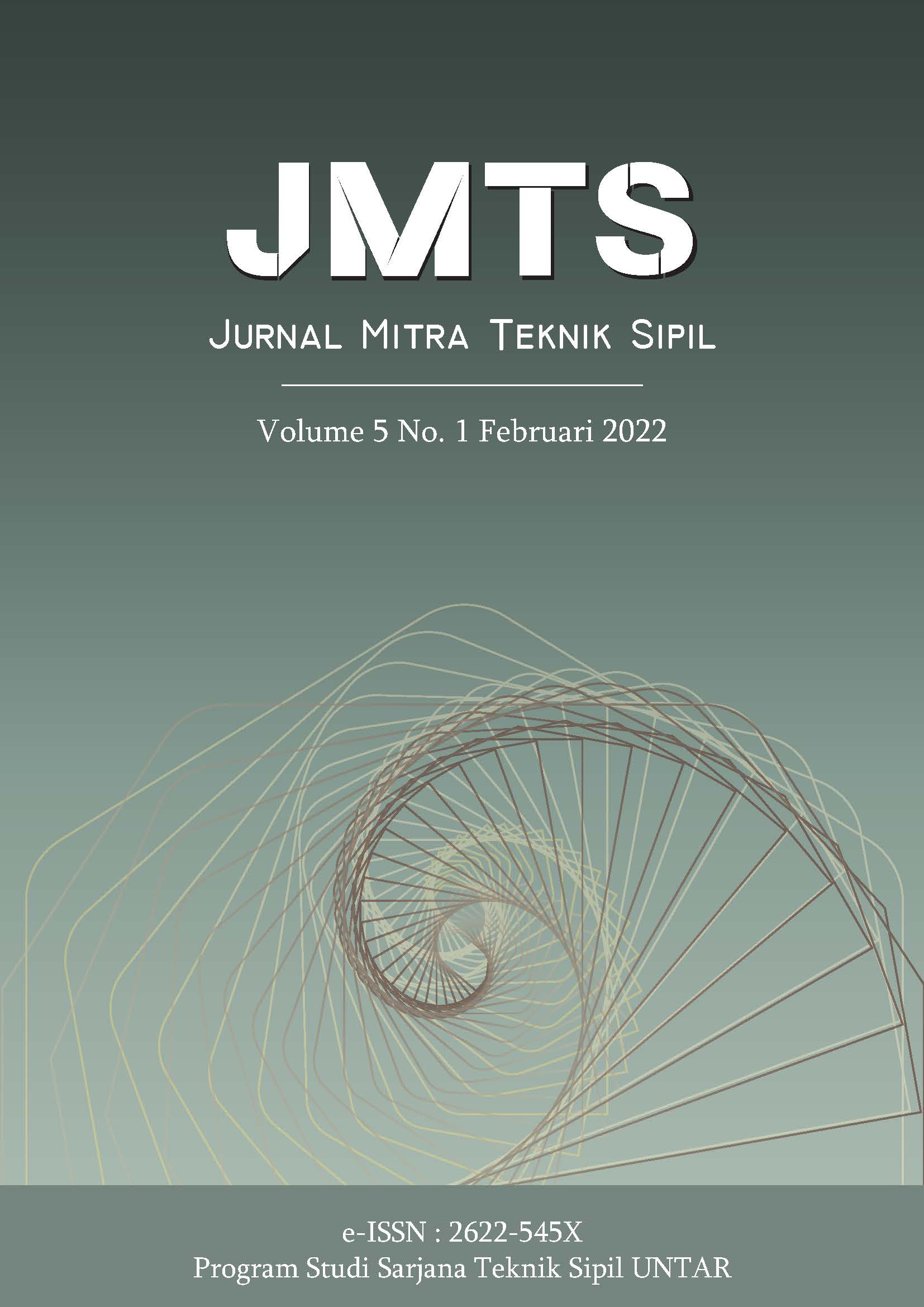ANALISIS DEFORMASI LATERAL MSE WALL DENGAN PERKUATAN GEOGRID TERHADAP VARIASI JENIS MATERIAL TIMBUNAN
Main Article Content
Abstract
ABSTRACT
The advantages of MSE walls are simple construction techniques, have aesthetic value and material resistance and are more economical. In this study, analysis was carried out on variations in anchor length, tensile strength and vertical spacing of the reinforcement elements, namely the geogrid, which was then modeled with sand and clay reinforcement soil. The analysis is carried out with the help of a finite element program, which will result in the value of the lateral deformation of the wall. Based on the analysis, the anchor length and tensile strength of the geogrid, the greater the anchor length and tensile strength, the smaller the resulting lateral deformation. Whereas at vertical distance, the results obtained are just the opposite. The results also show that the use of clay soils tends to be more stable in resisting lateral forces than sandy soils. Then in an effort to reduce the value of lateral deformation that occurs, further considerations can be focused on the selection of tensile strength or vertical spacing rather than the length of the anchorage. The results also produce a correlation equation that can be used to predict and determine the value of horizontal deformation according to the desired variation value.
ABSTRAK
Kelebihan dinding MSE ialah teknik konstruksi yang sederhana, punya nilai estetika dan ketahanan material serta lebih ekonomis. Pada penelitian ini, analisis dilakukan terhadap variasi panjang penjangkaran, kuat tarik dan spasi vertikal elemen perkuatannya yaitu geogrid, yang kemudian dimodelkan dengan tanah perkuatan pasir dan lempung. Analisis dilakukan dengan bantuan program metode elemen hingga, yang akan menghasilkan nilai deformasi lateral dari dinding MSE untuk dianalisis. Berdasarkan analisis, pada panjang penjangkaran dan kuat tarik geogrid, semakin besar nilai panjang penjangkaran dan kuat tariknya, maka semakin kecil deformasi lateral yang dihasilkan. Sedangkan pada jarak vertikal, hasil yang didapat justru sebaliknya. Perbandingan hasil juga didapat dari dua jenis tanah perkuatan yang berbeda, yang mana dapat disimpulkan bahwa pengunaan jenis tanah lempung cenderung lebih stabil dalam menahan gaya lateral dibandingkan dengan jenis tanah pasir. Kemudian untuk upaya mengurangi nilai deformasi lateral yang terjadi, pertimbangan lebih lanjut dapat difokuskan pada pemilihan kuat tarik ataupun spasi vertikalnya dibanding pada panjang penjangkarannya. Dari hasil analisis juga menghasilkan persamaan korelasi sehingga dapat digunakan untuk memprediksi dan menentukan nilai deformasi horizontal sesuai dengan nilai variasi yang diinginkan.
Article Details
References
Awwad, T., & Kodsi, S. Al. (2017). A comparison of Numerical Simulation Models to Determine the Location of Neutral Plane.
Badan Standarisasi Nasional. (2017). SNI 8460:2017 Persyaratan Perancangan Geoteknik. Badan Standarisasi Nasional.
Bowles, J. E. (1996). Foundation Analysis and Design. McGraw-Hill.
Bowles, J. E. (1997). Analisis dan Desain Pondasi Jilid 2. Penerbit Erlangga.
Coduto, & P., D. (1994). Foundation Design Principles and Practices. Prentice – Hall.
Das, B. M. (2006). Principles of Geotechnical Engineering 7th. PWS Publishers.
Elias, V., Barry R., C., & R. Berg, R. (2001). Mechanically Stabilized Earth Walls and Reinforced Soil Slopes Design & Construction Guidelines. U.S. Departement of Transportation Federal Highway Administration.
Emmanuel, B., Alain, C., & Truong Linh, C. (2013). Analysis of Long-term Deformations of MSE walls based on Various Corrosion Scenarios. Soils and Foundations, 259–271. https://doi.org/10.1016/j.sandf.2013.02.006
FHWA. (2009). Design and Construction of Mechanically Stabilized Earth Walls and Reinforced Soil Slopes. In Federal High Way Administration (FHWA): Vol. I. U.S. Departement of Transportation Federal Highway Administration. https://doi.org/FHWA-NHI-10-024 & FHWA-NHI-10-025
Ganda, I., & Roesyanto. (2012). Analisis Stabilitas Lereng Menggunakan Perkuatan Geogrid (Studi Kasus Jalan Medan – Berastagi, Desa Sugo). Teknik Sipil Universitas Sumatera Utara.
Hamdhan, I. N., & Pratiwi, D. S. (2017). Analisis Stabilitas Lereng dalam Penanganan Longsoran di Jalan Tol Cipularang Km. 91+200 dan Km. 92+600 Menggunakan Metode Elemen Hingga (FEM). Jurnal Rekayasa Hijau ISSN 2550-1070, 100–111.
Leshchinsky, D., & Han, J. (2004). Geosynthetic Reinforced Multitiered Walls. Journal of Geotechnical and Geoenvironmental Engineering.
Nazir, M. (1998). Metode Penelitian. Ghalia Indonesia.
Nuradi, A. P., & Ilyas, T. (2013). Analisis Perilaku Geogrid Terhadap Beban Dinamik (Gempa) dengan Metode Finite Element . Studi Kasus : Lereng Cipularang KM 96 + 900.
Salim, Y., & Suhendra, A. (2021). Analisis Stabilitas Back-To-Back Mechanically Stabilized Earth Walls (Studi Kasus Jalan Layang Di Sulawesi Selatan). JMTS: Jurnal Mitra Teknik Sipil, 657. https://doi.org/10.24912/jmts.v0i0.12582
Shanghai Yingfan Engineering Material. (2019). PP Biaxial Geogrid. https://www.yingfangeo.com/geogrid/biaxial-geogrid/pp-biaxial-geogrid.html
Stevens, D., & Tedianto, L. S. (2018). Analisis Pengaruh Panjang Elemen Terhadap Kuat Tekan Dari Baja Ringan Profil Kanal Dengan Metode Elemen Hingga. JMTS: Jurnal Mitra Teknik Sipil, 159. https://doi.org/10.24912/jmts.v1i1.2253
Terzaghi, K., Peck, R. B., & Mesri, G. (1996). Soil Mechanics in Engineering Practice 3rd Edition. John Wiley and Sons Inc.
The Reinforced Earth. (2021). Mechanically Stabilized Earth Retaining Walls. The Reinforced Earth Company. https://reinforcedearth.com/products/retaining-walls/mechanically-stabilized-earth-mse-retaining-walls
Tileco Inc. (2021). Tileco Keystone Brochure. Tileco Inc. https://www.tilecoinc.com/New/tileco_keystone.pdf
Verruijt, A. (2001). Soil Mechanics. Delft University of Technology - the Netherlands.



